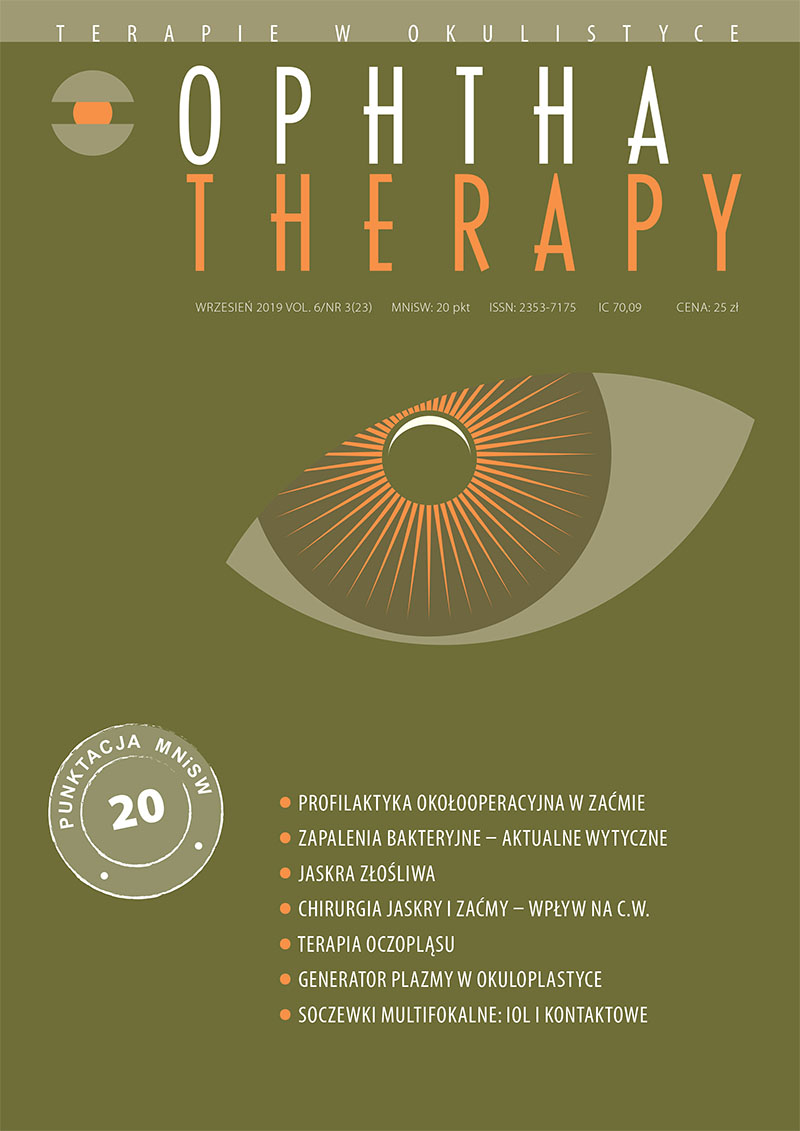Jaskra a zaćma – wpływ zabiegu fakoemulsyfikacji zaćmy oraz zabiegów łączonych na obniżenie ciśnienia wewnątrzgałkowego
##plugins.themes.bootstrap3.article.main##
Abstrakt
Jaskra, według danych WHO, jest drugą co do częstości przyczyną ślepoty na świecie, zaraz po zaćmie. Te dwie choroby bardzo często występują razem oraz wzajemnie na siebie wpływają. Postępowanie, od odpowiedniej kwalifikacji przez przeprowadzenie samego zabiegu oraz opieki pooperacyjnej, jest różne w zależności od stopnia zaawansowania, wcześniejszego przebiegu oraz leczenia każdej z tych chorób. Obecnie w społeczeństwie zdecydowanie rośnie liczba pacjentów z jaskrą potrzebujących również usunięcia zaćmy. Najczęstszą metodą jej usunięcia jest teraz zabieg fakoemulsyfikacji zaćmy ze wszczepieniem implantu sztucznej soczewki. Badania sugerują spadek ciśnienia wewnątrzgałkowego po takim zabiegu, co daje korzystny efekt, szczególnie u pacjentów leczonych z powodu jaskry. Nie jest on jednak długotrwały, dlatego też często stosowane są procedury łączące fakoemulsyfikację z zabiegiem przeciwjaskrowym, wywołujące dłużej trwające obniżenie ciśnienia wewnątrzgałkowego. Rezultat zależy oczywiście od wielu czynników, m.in. typu jaskry oraz wybranego zabiegu przeciwjaskrowego. W literaturze widnieje wiele doniesień z badań porównujących różne postępowania terapeutyczne w przypadku współistnienia tych dwóch głównych chorób okulistycznych.
Pobrania
##plugins.themes.bootstrap3.article.details##

Utwór dostępny jest na licencji Creative Commons Uznanie autorstwa – Użycie niekomercyjne – Bez utworów zależnych 4.0 Międzynarodowe.
Copyright: © Medical Education sp. z o.o. License allowing third parties to copy and redistribute the material in any medium or format and to remix, transform, and build upon the material, provided the original work is properly cited and states its license.
Address reprint requests to: Medical Education, Marcin Kuźma (marcin.kuzma@mededu.pl)
Bibliografia
2. Masis M, Mineaut PJ, Phan E et al. The role of phacoemulsification in glaucoma therapy: a systemic review and meta-analysis. Surv Ophthalmol. 2018; 63(5): 700-10.
3. Li T, Lindsley K, Rouse B et al. Comparative Effectiveness of First-Line Medications for Primary Open-Angle Glaucoma: A Systematic Review and Network Meta-analysis. Ophthalmology. 2016; 123(1): 129-40.
4. Tabin G, Chen M, Espandar L. Cataract surgery for the developing world. Curr Opin Ophthalmol. 2008; 19(1): 55-9.
5. Mansberger SL, Gordon MO, Jampel H et al. Reduction in intraocular pressure after cataract extraction: the Ocular Hypertension Treatment Study. Ophthalmology. 2012; 119(9): 1826-31.
6. Dias-Santos A, Ferreira J, Abegão Pinto L et al. Phacoemulsification versus peripheral iridotomy in the management of chronic primary angle closure: long-term follow-up. Int Ophthalmol. 2015; 35(2): 173-8.
7. Fea AM. Phacoemulsification versus phacoemulsification with micro-bypass stent implantation in primary open-angle glaucoma: randomized double-masked clinical trial. J Cataract Refract Surg. 2010; 36(3): 407-12.
8. Gedde SJ, Singh K, Schiffman JC et al. Tube Versus Trabeculectomy Study Group. The Tube Versus Trabeculectomy Study: interpretation of results and application to clinical practice. Curr Opin Ophthalmol. 2012; 23(2): 118-26.
9. Gupta SK. Intention-to-treat concept: A review. Perspect Clin Res. 2011; 2(3): 109-12.
10. Hayashi K, Hayashi H, Nakao F et al. Effect of cataract surgery on intraocular pressure control in glaucoma patients. J Cataract Refract Surg. 2001; 27(11): 1779-86.
11. Hou X, Hu D, Cui Z et al. Small-incision phacotrabeculectomy versus phacoemulsification in refractory acute primary angle closure with cataract. BMC Ophthalmol. 2015; 15: 88.
12. Husain R, Gazzard G, Aung T et al. Initial Management of Acute Primary Angle Closure: A Randomized Trial Comparing Phacoemulsification with Laser Peripheral Iridotomy. Ophthalmology. 2012; 119(11): 2274-81.
13. Iancu R, Corbu C. Intraocular pressure after phacoemulsification in patients with uncontrolled primary open angle glaucoma. J Med Life. 2014; 7(1): 11-6.
14. Issa SA, Pacheco J, Mahmood U et al. A novel index for predicting intraocular pressure reduction following cataract surgery. Br J Ophthalmol. 2005; 89(5): 543-6.
15. Jacobi PC, Dietlein TS, Krieglstein GK. Comparative study of trabecular aspiration vs trabeculectomy in glaucoma triple procedure to treat pseudoexfoliation glaucoma. Arch Ophthalmol. 1999; 117(10): 1311-8.
16. Kashiwagi K, Kashiwagi F, Tsukahara S. Effects of small-incision phacoemulsification and intraocular lens implantation on anterior chamber depth and intraocular pressure. J Glaucoma. 2006; 15(2): 103-9.
17. Kass MA, Heuer DK, Higginbotham EJ et al. The Ocular Hypertension Treatment Study: a randomized trial determines that topical ocular hypotensive medication delays or prevents the onset of primary open angle glaucoma. Arch Ophthamol. 2002; 120(6): 701-13.
18. Kim DD, Doyle JW, Smith MF. Intraocular pressure reduction following phacoemulsification cataract extraction with posterior chamber lens implantation in glaucoma patients. Ophthalmic Surg Lasers. 1999; 30(1): 37-40.
19. Lai JSM, Tham CCY, Chan JCH. The clinical outcomes of cataract extraction by phacoemulsification in eyes with primary angle-closure glaucoma (PACG) and coexisting cataract: a prospective case series. J Glaucoma. 2006; 15(1): 47-52.
20. Baek SU, Kwon S, Park IW et al. Effect of Phacoemulsification on Intraocular Pressure in Healthy Subjects and Glaucoma Patients. J Korean Med Sci. 2019; 34(6): e47.
21. Kim WJ, Kim JM, Lee WH et al. Effect of combined goniotomy and phacoemulsification on intraocular pressure in open‐angle glaucoma patients. Clin Exp Ophthalmol. 2019: 1-9.
22. Wang N, Jia SB. Phacoemulsification with or without goniosynechialysis for angle-closure glaucoma: a global Meta-analysis based on randomized controlled trials. Int J Ophthalmol. 2019; 12(5): 826-33.
23. Hayashi K, Yoshida M, Sato T et al. Effect of Topical Hypotensive Medications for Preventing Intraocular Pressure Increase after Cataract Surgery in Eyes with Glaucoma. Am J Ophthalmol. 2019. pii: S0002 9394(19)30118-7.
24. Guan H, Mick A, Porco T et al. Preoperative factors associated with IOP reduction after cataract surgery. Optom Vis Sci. 2013; 90(2): 179-84. https://doi.org/10.1097/OPX.0b013e31827ce224.

